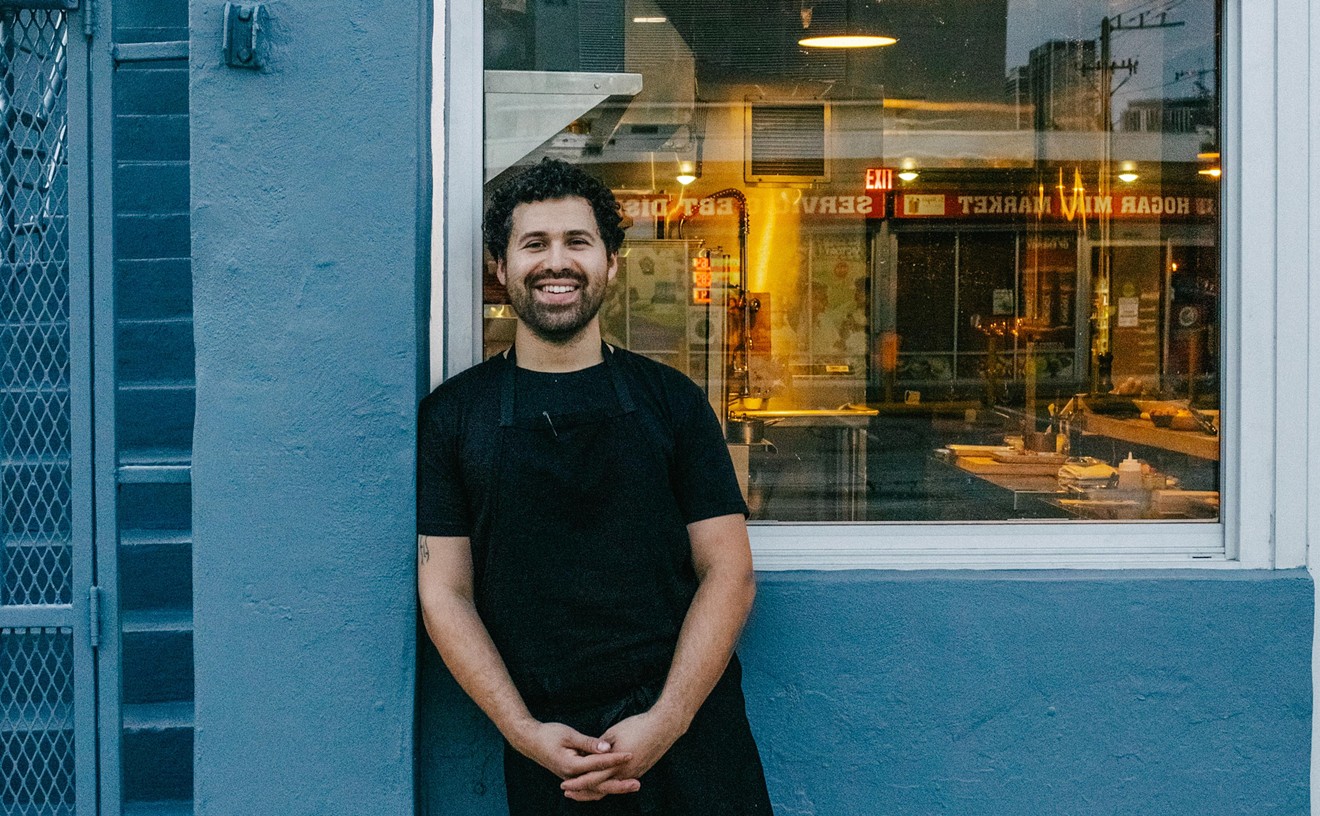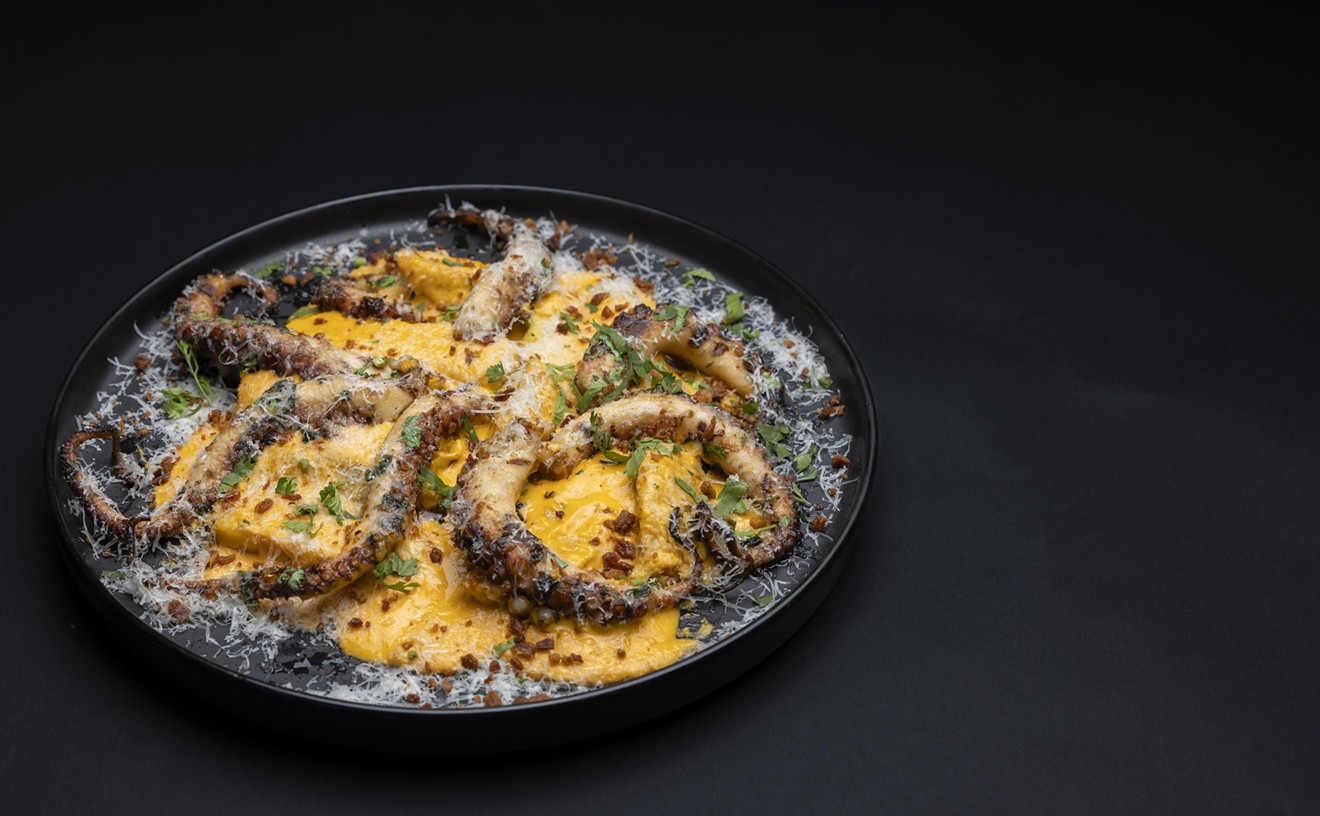There are various diamond-in-the-rough eateries set among the side streets of resurrected Homestead, but the one taquería and three restaurants discussed here shine right on Krome Avenue. You won't find the innovative Mexican cuisine of Eduardo San Angel or Divina at these places, but even the most conventional dishes are superior to the Tex-Mex dreck dredged up by local chains with goofy names. For one thing the food is fresher. That's partly owing to the aforementioned farmland but also because the cuisine is put together in the manner of real Mexican cooking: from scratch every day. So don't let the 40-mile drive down the turnpike from Miami deter you -- that's nothing for this opportunity to stock the car with fresh fruits and vegetables and fill the stomach with the real enchilada.
La Tapatia, owned by Hiberto Cendejas of Michoacan, offers the ambiance of an authentic Mexican taquería, meaning rickety enough to perhaps deter the less intrepid of culinary adventurers. Just as well, as there aren't many seats in this narrow shop that rustles up robust and extremely delicious versions of typical taquería street snacks -- from tacos to tostadas to tortas, crusty Mexican-style submarine sandwiches filled with lettuce, tomato, avocado, jalapeño, hot sauce, and a choice of meats such, as carne asada (steak), carnitas (stewed pork meat), roast chicken, and scrumptious ham that's baked onsite.
What it has that the others don't: great selection of baseball caps with colorful Mexican-league logos on sale for $7 to $12; the lowest prices, though the other restaurants visited also are inexpensive; starters that run from $4 to $7 and main courses ranging from $6 to $11.
What it does better than the rest: giant "barbacoa" burrito, bursting with piquant morsels of pork that have been marinated up to four days in ancho chili, garlic, pimiento, pineapple, and vinegar -- clearly the best on the block and only $4.50 ($3 for a smaller version).
Wooden blinds slant sunlight through the windows and on to colorful woven tablecloths at La Quebradita Restaurant, owned by Ecuadorian native Luis Aguirre (don't fret, the kitchen staff is Mexican). It's a somewhat small and intimate room and has the real feel of a restaurant in Mexico, rather than a Mexican restaurant in the United States. La Quebradita claims to make its own corn tortillas, though all the tortillas on Krome are locally prepared and taste pretty much the same -- which is to say not the coarse, cardboardy sort you get in supermarkets and commercialized Mexican eateries. You can tell the difference even when they're rolled and fried as flautas, five cigar-size cylinders filled with minced beef and topped with lettuce, tomatoes, and sour cream. Tomato-based rice and refried beans also are consistently tasty at these places; Quebradita's rice is distinguished by the addition of peas, carrots, and corn, and its pintos are of the properly soppy consistency. A grande burrito came fat with delectable chicken but there was too much cheese on top -- and mozzarella at that!
What it has that the others don't: the most genuine taco fillings -- sesos (beef brains), lengua (tongue), chicharrones (piquant pork rinds), and chorizo, puzzlingly absent from the other menus; horchata, a refreshing milky white beverage made from a sweetened rice base and flavored with vanilla and cinnamon -- it's really a liquid version of rice pudding, which turns out to be surprisingly thirst quenching; pleasant outdoor seating section; live guitar trio every Friday, from 7:00 to 9:00 p.m.
What it does better than the rest: corn tamales -- shredded beef surrounded by an almost puddinglike soft cornmeal masa steamed in sprightly yellow husks.
When Cesar Berrones and his family first opened Casita Tejas in 1987, it was across the street and up the block from its present location; the restaurant's moving service was Hurricane Andrew. This "Little House of Texas" serves heaping portions of Tex-Mex-influenced fare that just might have been the best we tried. Large storefront windows comprise the front wall of this bright and attractive room; spaciously arranged tables are covered in ocean-blue linen, and colorful Mexican murals are painted on sponged and stenciled walls. Starters are composed of the Americanized pleasers you might expect at Señor Frog's but are prepared with more aplomb -- and more chilis. These include Mexican bullets, explosive jalapeño peppers shot through with chicken, beef, or cheese and smothered in salsa and Monterey jack; and a fiesta sampler of quesadilla, flauta, tamal, and taco with beans, guacamole, sour cream, cheese dip, lettuce, and tomato -- obviously meant to be shared (though it costs only $7.75).
What it has that the others don't: superior seafood dishes, like eight giant shrimp grilled with garlic and chili guajillo, tilapia ceviche, and deep-fried whole red snapper; child's plate of taco or enchilada with rice, beans, and beverage for $3.25.
What it does better than the rest: mole (the other places were out of mole, so this tender roasted chicken leg and thigh under a spicy brown sauce, was the finest by default. It's a winner in any sense, possessing the proper undertone of chocolate, which acts as a velvet glove against the fiery fingers of smoked chilis); steak fajita, an ample portion of chili-spiced slices of seared flank served with guacamole, sour cream, and pico de gallo rife with ripe tomatoes as red as a bullfighter's cape; pinto beans cooked with jalapeños and pork rinds; desserts, particularly "chimi," a large flour tortilla fried with apples inside and crowned with caramel sauce and Cool Whip.
The 96 seats spread through two dining rooms make El Toro Taco Family Restaurant the largest of these eateries. It's also the most true to type, with terrazzo floors, dark wooden tables and chairs, and sombreros and bull horns and things hanging from the walls. Owned by the Hernandez family, who hail from San Luis Boticín, El Toro has been delighting locals with zesty Mexican dinners for 25 years. The menu is populated with old amigos like nachos, enchiladas, tacos, burritos -- need I go on? Chili relleno, a giant poblano pepper pumped with lots of moist white chicken strips and melted cheese, is battered with whipped egg whites, deep-fried, and capped with gobs of melted cheese and salsa, which tasted a bit too much like Italian tomato sauce. What should distinguish a Mexican red sauce is the searing of garlic, peppers, and tomatoes in a smoking hot pan, which adds the fabulously fathomless flavor that's lacking here.
What it has that the others don't: "zopes," which those who've traveled through Mexico will know as "sopes" -- fried handmade corn tortillas that are thick as patties, slightly larger than a silver dollar, and topped with shreds of chicken breast (or refried beans), lettuce, and queso blanco; a duo of steamy spinach and mushroom quesadillas spiked with savory seasonings and just the right amount of melted cheese; New Times "Best Ofs" hanging on the wall.
What it does better than the rest: salsa made from fresh tomatoes, onions, lime juice, and cilantro (superior to Casita Tejas's tomato-saucy version; Quebradita doesn't offer complimentary salsa and chips); menudo, a traditional soup/stew made with beef tripe and hominy, a favorite one-bowl meal of Northern Mexico, where it's often eaten for breakfast. I didn't try it at the other places, but can't imagine they could have served a heartier or better-tasting one than Toro.










